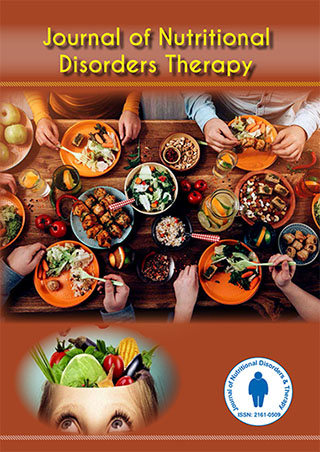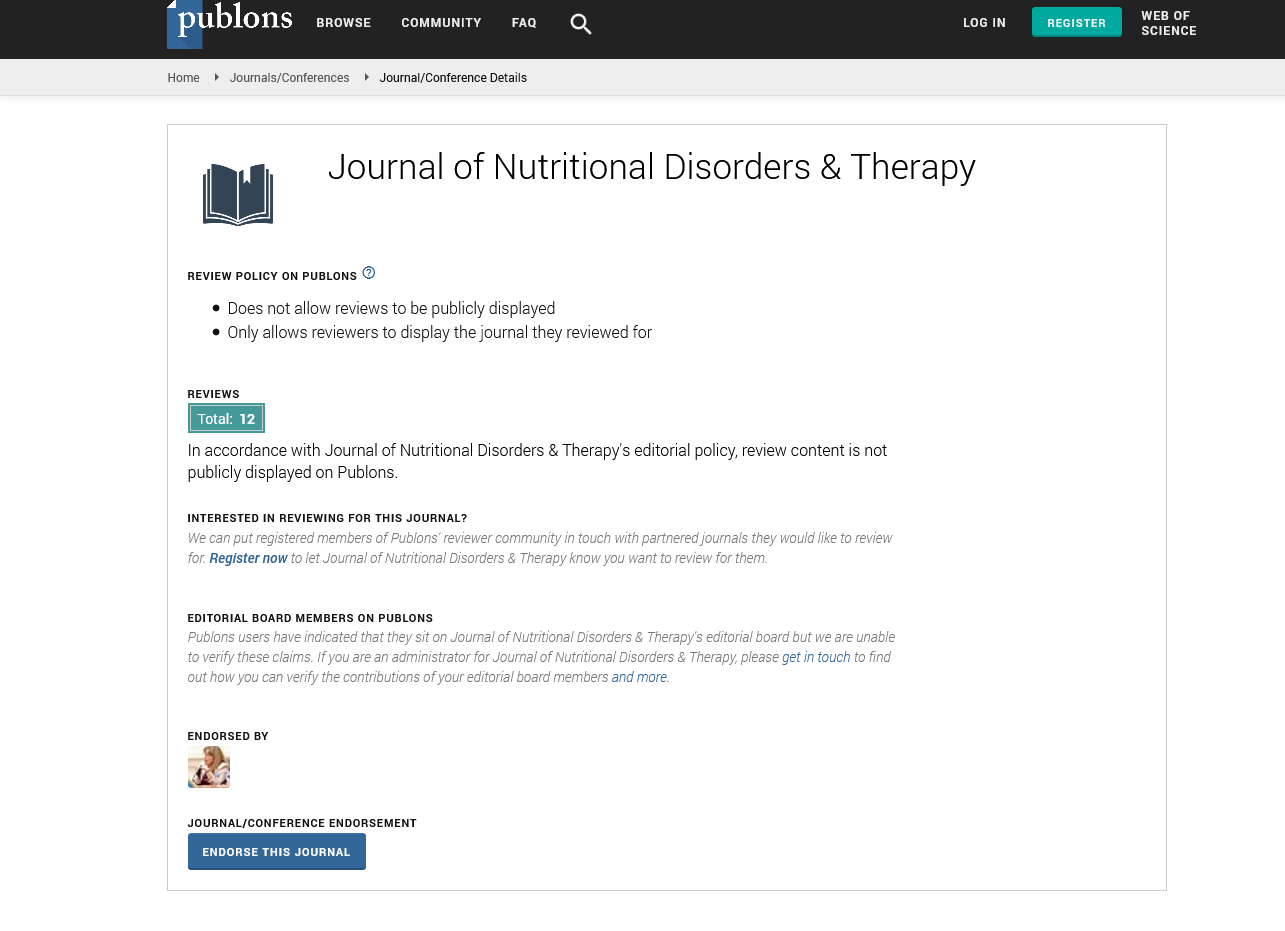Indexed In
- Open J Gate
- Genamics JournalSeek
- Academic Keys
- JournalTOCs
- Ulrich's Periodicals Directory
- RefSeek
- Hamdard University
- EBSCO A-Z
- OCLC- WorldCat
- Publons
- Geneva Foundation for Medical Education and Research
- Euro Pub
Useful Links
Share This Page
Journal Flyer

Open Access Journals
- Agri and Aquaculture
- Biochemistry
- Bioinformatics & Systems Biology
- Business & Management
- Chemistry
- Clinical Sciences
- Engineering
- Food & Nutrition
- General Science
- Genetics & Molecular Biology
- Immunology & Microbiology
- Medical Sciences
- Neuroscience & Psychology
- Nursing & Health Care
- Pharmaceutical Sciences
Commentary - (2025) Volume 15, Issue 2
Impact of Nutritional Decline on Outcomes after Hepatopancreatobiliary Tumor Resection
Donatella Franceschi*Received: 26-May-2025, Manuscript No. JNDT-25-29687; Editor assigned: 28-May-2025, Pre QC No. JNDT-25-29687 (PQ); Reviewed: 11-Jun-2025, QC No. JNDT-25-29687; Revised: 18-Jun-2025, Manuscript No. JNDT-25-29687 (R); Published: 25-Jun-2025, DOI: 10.35248/2161-0509.25.15.326
Description
Hepatopancreatobiliary (HPB) malignancies, encompassing cancers of the liver, pancreas and biliary tract, represent a challenging group of tumors characterized by high morbidity and mortality. Surgical resection remains the only potentially curative treatment for many patients with resectable disease. However, the prognosis following surgery varies significantly based on several preoperative factors. Among these, cancer cachexia a complex metabolic syndrome associated with underlying malignancy has gained increasing attention due to its strong association with poor postoperative outcomes.
Preoperative cachexia is marked by unintentional weight loss, skeletal muscle wasting and systemic inflammation. These alterations are not fully reversed by nutritional support and are distinct from starvation or general malnutrition. Cachexia is particularly common in patients with HPB malignancies and is often present before the initiation of treatment. This article examines the prognostic implications of preoperative cachexia in patients undergoing major HPB surgery and discusses its impact on perioperative outcomes, recovery and long-term survival.
Prevalence in HPB malignancies
Preoperative cachexia is common among individuals with pancreatic ductal adenocarcinoma, cholangiocarcinoma and hepatocellular carcinoma. Studies report that up to 60% of patients with pancreatic cancer exhibit features of cachexia at diagnosis. Liver cancer patients may also present with varying degrees of muscle wasting, especially those with underlying cirrhosis or chronic liver disease.
In these populations, weight loss and muscle wasting are often underestimated or misattributed to cancer-related fatigue or gastrointestinal symptoms. Advanced imaging techniques, such as Computed Tomography (CT) scans, have enabled more accurate measurement of muscle mass and have become instrumental in identifying sarcopenic cachexia.
Impact on perioperative outcomes
Several studies have identified preoperative cachexia as a negative predictor of perioperative outcomes following HPB surgery. Patients with cachexia often demonstrate increased rates of surgical site infections, higher incidence of delayed gastric emptying or pancreatic fistula, longer Intensive Care Unit (ICU) stays, delayed wound healing and elevated postoperative mortality. These complications may be attributed to a weakened immune response, poor tissue regeneration and impaired stress tolerance. Muscle wasting affects respiratory function and mobility, which are essential for recovery following major abdominal surgery. Furthermore, systemic inflammation in cachexia disrupts homeostasis, increasing susceptibility to infection and organ dysfunction.
Importantly, these risks persist even when patients meet basic nutritional requirements on clinical assessment. This underscores the distinct physiological burden imposed by cachexia, beyond what is measurable through weight or caloric intake alone.
Effects on long-term survival
Beyond perioperative risks, preoperative cachexia also correlates with inferior long-term outcomes in patients undergoing surgery for HPB malignancies. Multiple retrospective and prospective studies have shown that cachectic patients have shorter diseasefree survival, higher recurrence rates, lower overall survival at one and five years post-surgery.
In pancreatic cancer, where prognosis remains poor even with aggressive therapy, cachexia appears to be an independent predictor of early mortality. Similarly, patients undergoing liver resection for hepatocellular carcinoma with preexisting sarcopenia exhibit reduced survival, irrespective of tumor stage or liver function scores.
Cachexia may influence tumor biology through inflammatory pathways that promote metastasis and impair response to therapy. Additionally, patients with reduced functional reserve are less likely to tolerate adjuvant treatments, which further compromises survival.
Importance of multidisciplinary care
Given the multifaceted nature of cachexia, management requires collaboration among surgeons, dietitians, physiotherapists, oncologists and palliative care professionals. Early referral to nutritional services and integration of physical rehabilitation can support improved surgical outcomes.
Moreover, clear communication with patients and families regarding the risks associated with cachexia is essential. In some cases, it may influence decisions about the timing or appropriateness of surgery, particularly when functional decline is significant.
Preoperative cachexia exerts a measurable and significant impact on outcomes in patients undergoing major hepatopancreatobiliary surgery for malignancy. From increased perioperative complications to reduced long-term survival, its presence signals a higher risk of treatment failure and poorer overall prognosis. Identifying and addressing cachexia through comprehensive assessment and multidisciplinary intervention should be an integral part of surgical planning for patients with HPB cancers. As surgical care continues to evolve, recognizing the role of preoperative health, especially nutritional and functional status, remains essential to optimizing both survival and quality of life.
Citation: Franceschi D (2025). Impact of Nutritional Decline on Outcomes after Hepatopancreatobiliary Tumor Resection. J Nutr Disord Ther. 15:326.
Copyright: © 2025 Franceschi D. This is an open-access article distributed under the terms of the Creative Commons Attribution License, which permits unrestricted use, distribution, and reproduction in any medium, provided the original author and source are credited.

